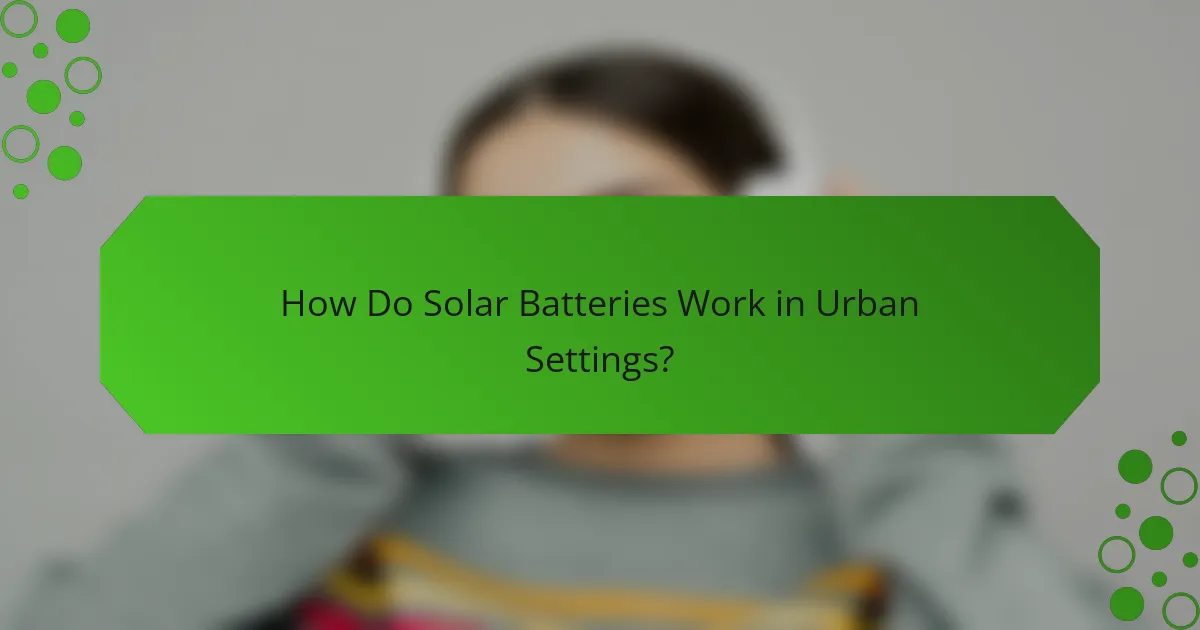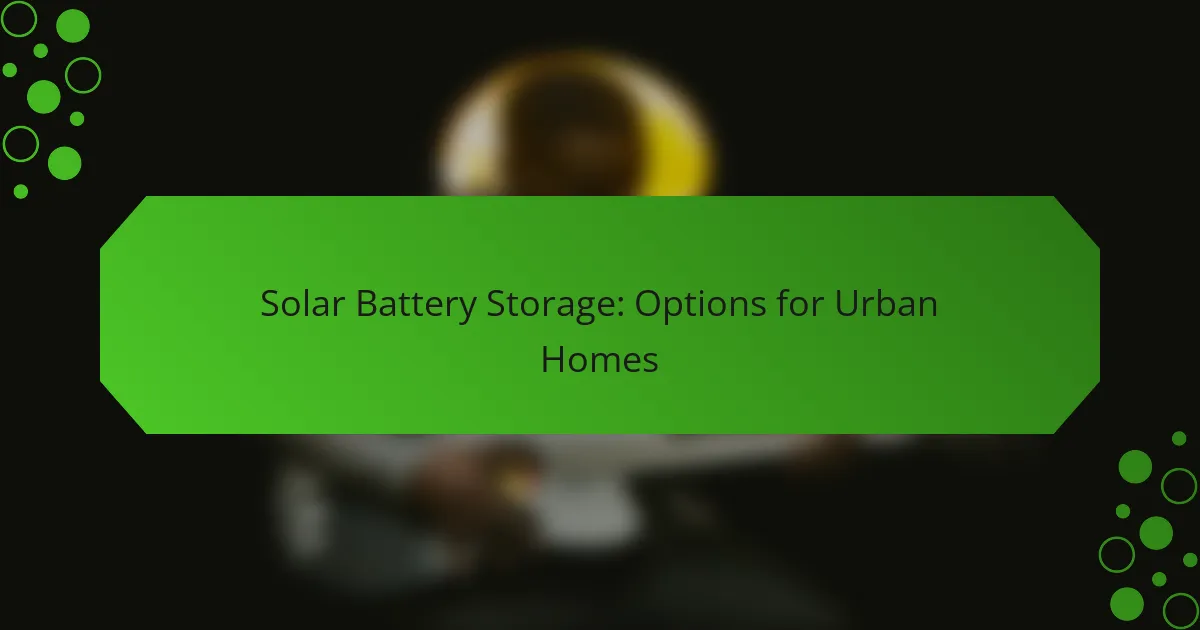Solar battery storage is an essential solution for urban homes looking to maximize energy efficiency and reduce reliance on the grid. By storing excess energy generated from solar panels, these systems enable homeowners to utilize renewable power even during cloudy days or at night, leading to significant cost savings and increased energy independence.

What Are the Best Solar Battery Storage Options for Urban Homes?
The best solar battery storage options for urban homes include systems that maximize efficiency and space utilization. These batteries help homeowners store excess solar energy for later use, reducing reliance on the grid and lowering electricity bills.
Tesla Powerwall
The Tesla Powerwall is a popular choice for urban homes due to its compact design and high storage capacity, typically around 13.5 kWh. It integrates seamlessly with solar panel systems and can be monitored via a smartphone app, allowing users to track energy usage and storage in real-time.
When considering the Powerwall, evaluate installation costs, which can vary widely based on local labor rates and existing solar infrastructure. The unit is designed for easy installation, but ensure you have a qualified installer to comply with local regulations.
Sonnen Eco
The Sonnen Eco battery system is known for its longevity and eco-friendly design, with capacities ranging from 10 kWh to 20 kWh. This system not only stores energy but also allows for smart energy management, optimizing usage based on household consumption patterns.
One key advantage of the Sonnen Eco is its modularity, enabling homeowners to expand their storage capacity as needed. However, the initial investment can be higher than other options, so it’s essential to assess your long-term energy needs before purchasing.
LG Chem RESU
The LG Chem RESU series offers flexible storage solutions with capacities from 6.5 kWh to 13.1 kWh, making it suitable for various urban home sizes. Its compact design allows for wall-mounted installation, saving valuable floor space.
Consider the RESU’s compatibility with your existing solar system, as it works best with specific inverters. Additionally, check for warranties and performance guarantees, as these can vary significantly between models.
Enphase Encharge
The Enphase Encharge battery system is designed for modularity, allowing homeowners to start with a smaller capacity and expand as needed. Each unit provides around 10 kWh of storage, making it a flexible option for urban settings.
Enphase’s unique microinverter technology enhances system efficiency and reliability. Be mindful of installation requirements and ensure you have a certified installer familiar with Enphase products to maximize performance.
Generac PWRcell
The Generac PWRcell system combines solar energy storage with backup power capabilities, offering up to 17.1 kWh of storage. It’s particularly beneficial for urban homes prone to outages, providing peace of mind during emergencies.
When evaluating the PWRcell, consider its scalability, as homeowners can add additional battery units to increase storage capacity. Additionally, check local incentives or rebates that may apply to battery storage systems, which can help offset initial costs.

How Do Solar Batteries Work in Urban Settings?
Solar batteries in urban settings store excess energy generated by solar panels for later use, enhancing energy efficiency and reliability. They allow homeowners to utilize solar power even during non-sunny periods, reducing reliance on the grid.
Energy storage mechanism
Solar batteries primarily use lithium-ion technology, which is efficient and compact, making it suitable for urban homes with limited space. These batteries charge during the day when solar panels produce surplus energy and discharge stored energy during peak usage times, such as evenings.
Homeowners should consider the battery’s capacity, typically measured in kilowatt-hours (kWh), to ensure it meets their energy needs. A common range for residential batteries is between 5 kWh to 15 kWh, depending on household consumption patterns.
Integration with solar panels
Integrating solar batteries with solar panels requires a compatible inverter that manages energy flow between the panels, battery, and home. This setup allows for seamless charging and discharging, optimizing energy usage.
Homeowners should assess their solar panel system’s output to determine the appropriate battery size. A well-matched system can significantly enhance energy independence and reduce electricity bills over time.
Grid connection benefits
Connecting solar batteries to the grid offers several advantages, including the ability to sell excess energy back to the grid through net metering. This can provide additional income or credits on electricity bills, making solar investments more financially viable.
Moreover, during power outages, batteries can provide backup power, ensuring essential appliances remain operational. Urban homeowners should check local regulations regarding grid connections and net metering policies to maximize these benefits.

What Are the Key Benefits of Solar Battery Storage?
Solar battery storage offers several advantages for urban homes, including energy independence, cost savings, and reliable backup power during outages. By storing excess solar energy, homeowners can optimize their energy usage and reduce reliance on the grid.
Energy independence
Solar battery storage enhances energy independence by allowing homeowners to generate and store their own electricity. This reduces dependence on utility companies and protects against fluctuating energy prices.
For urban residents, this means having a more stable energy supply, especially in areas where grid reliability may be an issue. By utilizing stored solar energy during peak hours, homeowners can avoid high electricity rates.
Cost savings
Investing in solar battery storage can lead to significant cost savings over time. By storing energy generated during the day, homeowners can use it during the evening when electricity rates are typically higher.
In many regions, homeowners can also take advantage of net metering policies, which allow them to sell excess energy back to the grid. This can further offset installation costs and lead to a quicker return on investment.
Backup power during outages
Solar battery systems provide essential backup power during outages, ensuring that critical appliances and devices remain operational. This is particularly valuable in urban areas where power interruptions can occur due to high demand or infrastructure issues.
Homeowners can choose battery systems with sufficient capacity to support essential functions, such as refrigeration and lighting, for several hours or even days, depending on the size of the battery and energy consumption.

What Factors Should You Consider When Choosing a Solar Battery?
When selecting a solar battery, consider factors such as capacity, warranty, and compatibility with your existing solar system. These elements will significantly influence the battery’s performance, longevity, and overall effectiveness in your urban home.
Capacity and power rating
The capacity of a solar battery indicates how much energy it can store, typically measured in kilowatt-hours (kWh). For urban homes, a battery with a capacity ranging from 5 kWh to 15 kWh is common, depending on your energy needs and usage patterns.
Power rating, measured in kilowatts (kW), reflects how much energy the battery can deliver at any given moment. A higher power rating is essential for running multiple appliances simultaneously, especially during peak usage times.
Warranty and lifespan
Warranty and lifespan are critical when evaluating solar batteries. Most batteries come with warranties ranging from 5 to 15 years, which can indicate their expected lifespan and reliability. A longer warranty often suggests greater confidence from the manufacturer in the product’s durability.
Consider the cycle life of the battery, which refers to how many charge and discharge cycles it can undergo before its capacity significantly diminishes. Look for batteries with a cycle life of at least 3,000 to 5,000 cycles for optimal longevity.
Compatibility with existing systems
Ensuring compatibility with your current solar setup is vital for seamless integration. Check if the battery is compatible with your inverter and solar panels, as mismatches can lead to inefficiencies or increased costs.
Some batteries are designed for specific brands or systems, while others offer broader compatibility. Researching your options and consulting with a professional can help you avoid potential pitfalls and ensure a smooth installation process.

What Are the Costs of Solar Battery Storage in Urban Areas?
The costs of solar battery storage in urban areas can vary significantly based on factors like system size, battery type, and installation specifics. Generally, homeowners can expect to invest several thousand to over ten thousand USD for a complete solar battery system.
Initial investment estimates
The initial investment for solar battery storage typically ranges from around 5,000 to 15,000 USD, depending on the capacity and technology of the battery. For instance, lithium-ion batteries, which are popular for their efficiency and longevity, may cost more upfront compared to lead-acid options.
When considering installation, additional costs such as labor, permits, and potential upgrades to your electrical system should be factored in. Homeowners should also evaluate available incentives, such as tax credits or rebates, which can significantly reduce the overall expense.
To make an informed decision, it’s advisable to obtain multiple quotes from local installers and assess the long-term savings on energy bills. Comparing the total cost of ownership over the battery’s lifespan can provide a clearer picture of the financial benefits.
